Introducción
Welcome
Welcome to the module in Scientific writing. This module is designed so you get exposure to scientific writing. Of course, all of us have wrote some kind of paper, abstract or essay about science. The question is, How effective you has been in communicating your ideas? Scientific writing is a little bit different than creative writing and than science writing and it is govern by a different set of rules. Yes, been a scientist is a little bit different, the way we communicate between ourselves, and how we communicate with general public. The vocabulary that we use, the assertivity that is needed, the documentation of the fact that support our communication, the maximizing use of time and space, using tables and graphs to not only to present data, but to be able to present tendencies and relationships among the data. Indeed, this is scientific writing.
The goal of this module is to introduce the students to scientific writing. To accomplish it we will carry out the following objectives:
(1) to present the fundamentals of scientific writing,
(2) to present the difference between scientific writing, science writing and creative writing,
(3) to present a methodology on how to write an effective abstract,
(4) how to write an effective scientific essay.
Each of these objectives are a topic in the module. After completion of the module, you will be able to familiarize yourself with scientific writing.
Each topic consists of an introduction in which we will highlight the key elements of the topic, some will have a PowerPoint presentation about the topic, and a practice exercise in which you will apply what you learn in the topic. It is important that you will go through the topics in this order. First, read the introduction, second, view the PowerPoint presentation, then go back to the introduction and re-read it (I am sure you will find a richer meaning of it the second time), and third, do the practice exercises. You will also find some references in each topic that will allow you to explore in deep the topic, get new knowledge and help you construct your own knowledge of the topic. Finally, you will find a checklist of the components that need to be present in an effective abstract or essay. Make sure you verify your document to ensure all the elements are present.
Great, let’s begin.
Lección 1: Fundamentals of Scientific Writing
Fundamentals of Scientific Writing
Great, I am glad that you decided to explore this topic. In this topic we will see the principles that govern the scientific writing process. In order to understand them, it is important that we know what is scientific writing?
Scientific Writing
According to Dr. Rick Lombardo from University of Nebraska-Lincoln, he defines it as:
Scientific writing is not just writing about science; it is the technical writing that scientists do to communicate their research to others.
I agree with this definition, because scientific writing is govern by the rigurosity of the science disciplines. Rigurosity that is characterize by:
- concise
- precise
- based on facts
- assertive
- clarity
- cohesive
- accuracy
- objectivity
It is time to watch the PowerPoint presentation. Surprise, the presentation is in Spanish, the reason for that is because majority of the students at our institution their first language is Spanish, and I want to make sure that all of you get the point.
escritura-cientifica-Inter-grad-2021-planas.pdf
Let do some practice, the following sentences are bad example of scientific writing. Analyze them and decide why they are bad examples.
What is the problem with this sentence?
“If possible, it is suggested to plant buffers using a three-zone approach.”
Indeed the problem is ______________. Write a better sentence.
What is the problem with this paragraph?
“International policies like the Kyoto Protocol have emphasized the need to increase efforts to reduce greenhouse gas (GHG) emissions and increase carbon storage in non-atmospheric pools. Harvested wood products (HWPs) include all wood materials that leave a forest after a harvest. Not only are they important for certain sectors of the economy, such as shipping and manufacturing, but they also serve as a terrestrial carbon stock.”
Indeed the problem is ______________. Write a better paragraph.
What is the problem with this paragraph?
“As a civil engineering intern, I worked with the Facilities Management Services Division to execute daily activities in response to workplace issues. Sign Inventory was my main area of research. I helped investigate over 500 signs based on their reflectivity and compliance with federal guidelines.” (45 words)
Indeed the problem is ______________. Write a better paragraph.
Now it is time to see the answers. Click on the link below to see them.
References:
- Eslava-Schmalbach, J.; Gomez-Duarte, O. G. 2013. Revista Colombiana de Anestesiología. 41(2):79-81
- Rodriguez de Fonseca, Belen. Escritura Cientifica. Facultad de Fisica. Universidad Complutense de Madrid. https://www.ucm.es/data/cont/media/www/pag-90674/taller%20escritura.pdf
- Gordillo Alfonso, A. 2017. La escritura científica: una revisión temática. Signo y Pensamiento, vol. XXXVI, núm. 71, pp. 52-64 Pontificia Universidad Javeriana Bogotá, Colombia. https://www.redalyc.org/pdf/860/86054913003.pdf
Lección 2: Scientific vs. Science vs. Creative Writings
Scientific vs. Science vs. Creative Writings
Introduction
Welcome, to the second topic of this module. Here we will deal with the differences between Scientific versus Science versus Creative writing. This is important for you to decide what type of communication are you dealing with, as well as, to determine if you are complying with the characteristics that define the type of communication that you are doing.
The objective of this topic are:
- To define Scientific writing, Science writing and creative writing
- To show the differences between them
- To recognize the type of writing in a manuscript
Before we continue with the definitions there is a point that I want to make clear. No matter what you are going to communicate, or in what topic, there are three questions that you need to answer clearly before you try to write. These questions are:
- What I want to communicate?
- To whom I am communicating?
- What I want them to do with the information that I am communicating?
The answers to these questions will determine if you are doing scientific writing (if your audience are scientist); science writing (if your audience is general public) or creating writing (if you are doing and exposure instead of communicating data). They will also determine the characteristics of your writing and it effectiveness.
Definitions:
Scientific writing is the way that scientist communicate their findings among the scientific community. It is a precise, concise, data based, objective and with clarity and clear scientific logic. Usually publish in peer review journals
Science writing is the way science is communicated to the general public and /or to non scientist communities. It is less technical than scientific writing, ideas are more general and uses analogies, metaphors among other language tools. Usually publish in magazines, newspapers or press releases. It is talking science to non scientist.
Creative writing is the way people communicate when they are not communicating scientific data. We see it when we read literature, art, economics and social sciences among other disciplines.
Differences between them:
You will find several documents that shows the difference between them. The first one is a table that compare creative writing with scientific writing using eleven criteria. The second, is a PowerPoint slide that compares the scientific writing with science writing. The third is a poster that show differences between scientific vs, science writing. In this one the IMRaD means (Introduction-Methodology-Result-Discusion) format; which is the format of the majority of peer review journals.
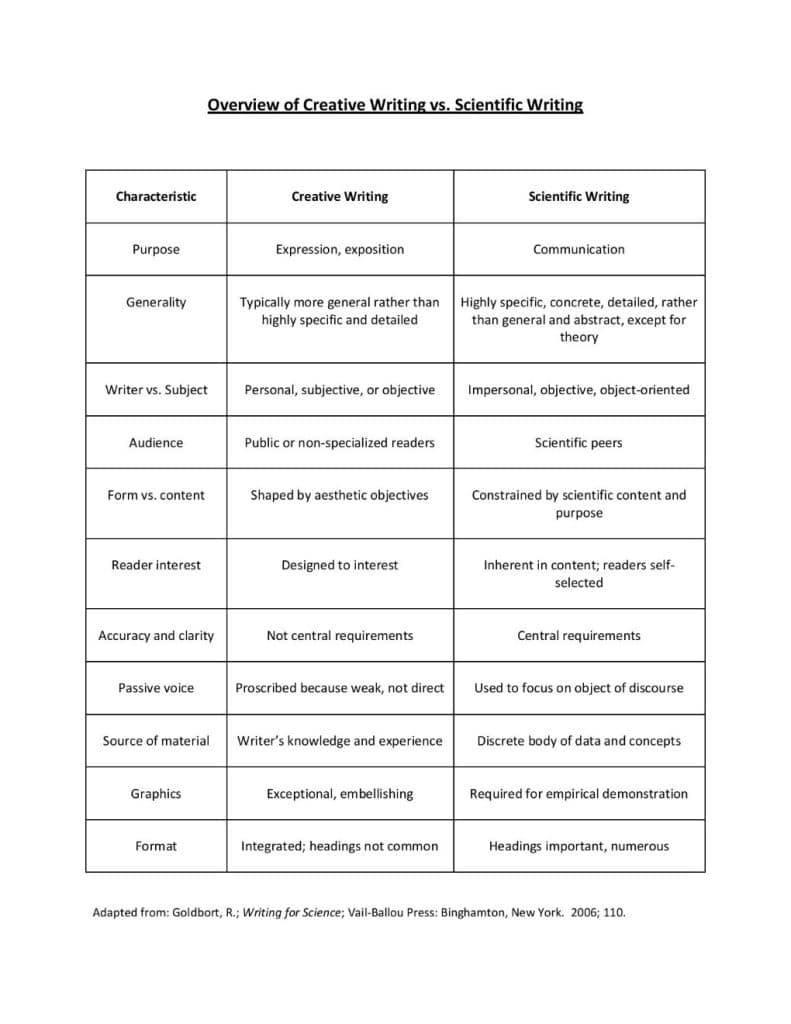


Practice
Each of the following links bring you to a document, analyze it and determine if it is written in Scientific writing, or Science writing, or Creative writing.
- Analysis of 6.4 million SARS-CoV-2 genomes identifies mutations associated with fitness.html
- Headbutts hurt the brain, even for a musk ox _ Science News.html
References
- Eslava-Schmalbach, J.; Gomez-Duarte, O. G. 2013. Revista Colombiana de Anestesiología. 41(2):79-81
- Rodriguez de Fonseca, Belen. Escritura Cientifica. Facultad de Fisica. Universidad Complutense de Madrid. https://www.ucm.es/data/cont/media/www/pag-90674/taller%20escritura.pdf
- Gordillo Alfonso, A. 2017. La escritura científica: una revisión temática. Signo y Pensamiento, vol. XXXVI, núm. 71, pp. 52-64 Pontificia Universidad Javeriana Bogotá, Colombia. https://www.redalyc.org/pdf/860/86054913003.pdf
- https://sites.google.com/site/fundamentosdeinvestigacionsht/unidad-3-herramientas-de-comunicacion-oral-y-escrita-en-la-investigacion/3-3-caracteristicas-del-lenguaje-cienti
- https://studylib.net/doc/8696633/10-characteristics-of-scientific-writing
Lección 3: Abstract
https://study.com/academy/lesson/how-to-write-a-scientific-abstract.html
Abstract
Introduction
Nice, you are now in the third topic of the module, excellent, keep the good work.
One of the nightmare of a science student is when their professors tell them to write an abstract. Students often think, How I do an abstract? I have no idea how to do it. My friend, do not worry, after completing this topic you will know how to do it.
After completing this topic the student will be able to:
- define what is an abstract
- mention the difference between types of abstract
- learn a procedure, a method to write an effective abstract
In order to be effective in writing an abstract it is important that you have very clear the answer to this three questions.
- What I want to communicate?
- To whom I am communicating it?
- What I want them to do with the information?
These answers will help you to decide the type of abstract, will give you clarity of though in the message you want to communicate and will allow you to evaluate your abstract once you have finished.
It is time to watch the Power Point presentation. This presentation will show you what is an abstract, the different types of abstracts and more important it will give you the methodology of how to do it. One thing that you should notice, is that an abstract is not written in one week. It take time, and at least four to five drafts before you have a final, effective abstract. Therefore, start writing it at least one month prior than the due date. You see, the experience of writing an abstract should be a joyful one, after all, you are communicating the fruit of your hard work in the lab, you are making a contribution to science; that my friend is an accomplishment.
Power Point Presentation
Click over the link below the image to have access to the Power Point Presentation.
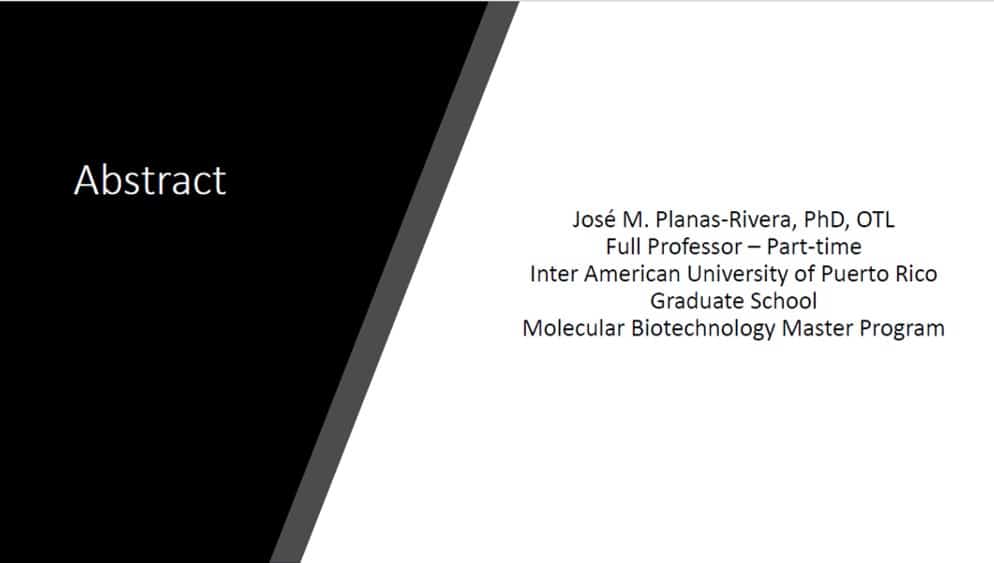
Practice exercises
Yes, it is time to see how well we understood the concepts. In this section you will find three links. Each one will bring you to a written abstract. Read the abstract and make a decision of what type of abstract is and document your decision in a piece of paper. Later on, after finishing analyzing the three abstract, check your responses with the response document find at the end of this section.
Abstract 2 – Practice
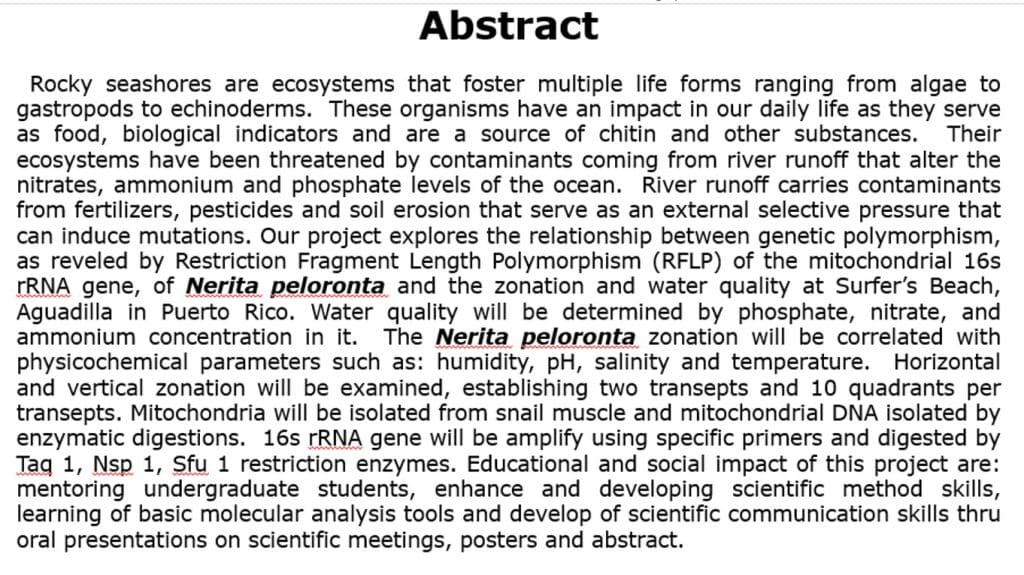
Abstract 3 – Practice

https://www.nature.com/articles/s41586-022-04420-x
Use the following checklist to verify if the abstracts contains all their elements.
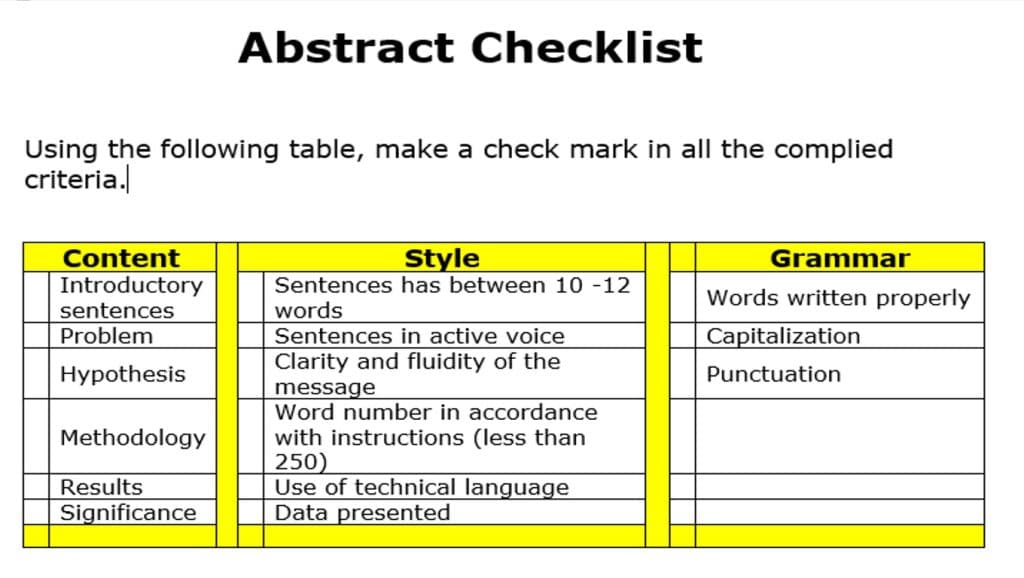
Resources
- https://writingcenter.gmu.edu/guides/writing-an-abstract
- https://services.unimelb.edu.au/__data/assets/pdf_file/0007/471274/Writing_an_Abstract_Update_051112.pdf
References
Lección 4: The Personal Statement
The Personal Statement
Introduction
Congratulations, you are in the last topic of this module. This topic is one of vital importance, it will help you to be able to apply for travel awards, admission to PhD Schools, obtain scholarships even to obtain a job. In this topic you will learn how to present yourself using the scientific writing style. Yes, you are the message,(your skills, your knowledge, your critical thinking, your soft skills, your experiences and much more), that need to be communicated.
The objective of this topic are:
- to learn how to present yourself in an effective way
- to learn how to join all your data such that it makes sense
- to be precise, concise and base on facts with respect to your qualities, skills and knowledge
Learning how to do the personal statement will also help you to be able to write papers, thesis and proposals.
Power Point Presentation
In this section you will find two Power Point presentations, the first one will show you what is a personal statements, the characteristics of a personal statement, de Do’s and Dont’s of a personal statement. It also tell you how to do the fluidity diagram as well as the parts that should include in the personal statement and will show you some examples of it.
The second one, is a good complement to the first presentations and shows some extra examples of personal statements.
How-to-write-a-personal-statement-Planas-Inter.pdf
Practice
Using the Personal statement-Fluidity Diagram shown as a guide, Construct your own personal statement using the empty diagram that you will find in the link below.

Fluidity Diagram Link
References





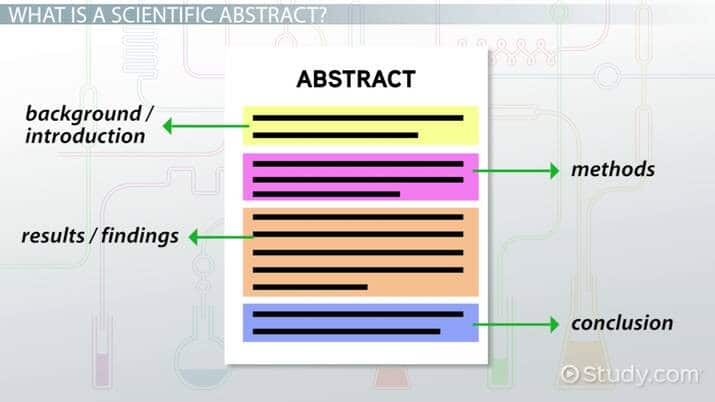

 Durante toda mi vida me ha apasionado las ciencias biologías y comencé mi preparación académica con un BS. en Microbiología Industrial en la UPR- Recinto de Mayagüez, me fui a Florida y realicé MS en Biología Molecular y Microbiología en UCF, donde realicé investigación en producción de biofármacos en el cloroplasto de planta transgénicas. Por último, realicé un PhD. en Ciencias Ambientales con especialidad en Biología en UAGM Gurabo, donde realicé mi disertación en biotecnología ambiental. Como profesor universitario con formación especializada en microbiología, biotecnología, he dedicado mi carrera a la docencia, el desarrollo curricular y la investigación aplicada en sistemas biotecnológicos sostenibles. A lo largo de los últimos años, he diseñado e impartido cursos a nivel subgraduado y graduado en temas como técnicas de cultivo celular, genética molecular, bioinformática y biotecnología agrícola y ambiental, con un enfoque particular en el aprendizaje activo y basado en investigación.
Durante toda mi vida me ha apasionado las ciencias biologías y comencé mi preparación académica con un BS. en Microbiología Industrial en la UPR- Recinto de Mayagüez, me fui a Florida y realicé MS en Biología Molecular y Microbiología en UCF, donde realicé investigación en producción de biofármacos en el cloroplasto de planta transgénicas. Por último, realicé un PhD. en Ciencias Ambientales con especialidad en Biología en UAGM Gurabo, donde realicé mi disertación en biotecnología ambiental. Como profesor universitario con formación especializada en microbiología, biotecnología, he dedicado mi carrera a la docencia, el desarrollo curricular y la investigación aplicada en sistemas biotecnológicos sostenibles. A lo largo de los últimos años, he diseñado e impartido cursos a nivel subgraduado y graduado en temas como técnicas de cultivo celular, genética molecular, bioinformática y biotecnología agrícola y ambiental, con un enfoque particular en el aprendizaje activo y basado en investigación. Beatriz González Ruiz es estudiante del programa de Biología en la Universidad Interamericana de Puerto Rico, Recinto de Aguadilla. Participará en el simposio con una presentación tipo afiche, titulada «Evaluation of Plankton Diversity in the Beaches of Aguadilla, Puerto Rico«. Su futura área de estudio es Farmacia o Farmacología. Su motivación para realizar esta investigación surge de explorar la gran diversidad de especies de plankton, las cuales son indicadores clave para la salud marina. Esto, con el propósito de educar a la comunidad sobre su gran importancia en los ecosistemas acuáticos, y crear conciencia sobre la protección hacia nuestros cuerpos de agua.
Beatriz González Ruiz es estudiante del programa de Biología en la Universidad Interamericana de Puerto Rico, Recinto de Aguadilla. Participará en el simposio con una presentación tipo afiche, titulada «Evaluation of Plankton Diversity in the Beaches of Aguadilla, Puerto Rico«. Su futura área de estudio es Farmacia o Farmacología. Su motivación para realizar esta investigación surge de explorar la gran diversidad de especies de plankton, las cuales son indicadores clave para la salud marina. Esto, con el propósito de educar a la comunidad sobre su gran importancia en los ecosistemas acuáticos, y crear conciencia sobre la protección hacia nuestros cuerpos de agua.
 Andrea N. Arce Rodríguez es estudiante del programa de Biología en la Universidad Interamericana de Puerto Rico, Recinto de Aguadilla. Participara en el simposio con una presentación oral, titulada “Evaluating the toxic effects chromium: My experience with the Wise lab”. Andrea aspira entrar a una escuela de medicina, para realizar un MD/PhD. Su motivación para realizar esta investigación surge de su pasión e interés hacia la toxicología y cómo las sustancias afectan a los seres vivos y a los ecosistemas.
Andrea N. Arce Rodríguez es estudiante del programa de Biología en la Universidad Interamericana de Puerto Rico, Recinto de Aguadilla. Participara en el simposio con una presentación oral, titulada “Evaluating the toxic effects chromium: My experience with the Wise lab”. Andrea aspira entrar a una escuela de medicina, para realizar un MD/PhD. Su motivación para realizar esta investigación surge de su pasión e interés hacia la toxicología y cómo las sustancias afectan a los seres vivos y a los ecosistemas.

 Khetzie M. González Guerrero es estudiante del programa de Toxicología en la Universidad Interamericana de Puerto Rico, Recinto de Aguadilla. Participará en el simposio con una presentación de afiche titulada “Characterization of UV-induced cell line”. Su futura área de estudio es Salud Pública. Su motivación para realizar esta investigación surge del interés en comprender cómo el cuerpo responde a factores ambientales que afectan la salud de las barreras epiteliales.
Khetzie M. González Guerrero es estudiante del programa de Toxicología en la Universidad Interamericana de Puerto Rico, Recinto de Aguadilla. Participará en el simposio con una presentación de afiche titulada “Characterization of UV-induced cell line”. Su futura área de estudio es Salud Pública. Su motivación para realizar esta investigación surge del interés en comprender cómo el cuerpo responde a factores ambientales que afectan la salud de las barreras epiteliales. La profesora Aris A. Román Silva posee un Doctorado en Filosofía con especialidad en Psicología Industrial Organizacional de la Universidad de Puerto Rico, Recinto de Río Piedras, así como una Maestría en Administración de Empresas de la Universidad de Puerto Rico, Recinto de Mayagüez. Esta sólida formación académica le permite integrar perspectivas psicológicas y gerenciales en la docencia, la investigación y el desarrollo institucional. Sus áreas de mayor interés investigativo son las dinámicas sociales y culturales que afectan el entorno de los individuos, así como las estructuras organizacionales y su influencia en el bienestar individual y colectivo. Demuestra un fuerte compromiso con la aplicación de metodologías cuantitativas y cualitativas para el análisis de fenómenos psicológicos, sociales y organizacionales, con énfasis en la formación de competencias investigativas en estudiantes del nivel graduado.
La profesora Aris A. Román Silva posee un Doctorado en Filosofía con especialidad en Psicología Industrial Organizacional de la Universidad de Puerto Rico, Recinto de Río Piedras, así como una Maestría en Administración de Empresas de la Universidad de Puerto Rico, Recinto de Mayagüez. Esta sólida formación académica le permite integrar perspectivas psicológicas y gerenciales en la docencia, la investigación y el desarrollo institucional. Sus áreas de mayor interés investigativo son las dinámicas sociales y culturales que afectan el entorno de los individuos, así como las estructuras organizacionales y su influencia en el bienestar individual y colectivo. Demuestra un fuerte compromiso con la aplicación de metodologías cuantitativas y cualitativas para el análisis de fenómenos psicológicos, sociales y organizacionales, con énfasis en la formación de competencias investigativas en estudiantes del nivel graduado. El Dr. Jorge A. Agudo Ruiz es catedrático auxiliar en el Departamento de Ciencias y Tecnología de la Universidad Interamericana de Puerto Rico, Recinto de Aguadilla. El Dr. Agudo imparte cursos en ciencias biológicas a nivel subgraduado y graduado. También, es presidente del Senado Académico y del Comité de Política Educativa del Consejo Universitario. Anteriormente, fungió como Coordinador de Avalúo del Aprendizaje, Especialista en Desarrollo Curricular, Especialista en Investigación y Extensión, y ha colaborado con acreditaciones institucionales. También, se desempeña como consejero académico de dos organizaciones estudiantiles en el Recinto: Sociedad Estudiantil de Toxicología y Juventud Universitaria Católica. Sus intereses de investigación están relacionados con la calidad del agua y la diversidad microbiológica en las playas del área oeste de Puerto Rico. Su formación académica incluye un Doctorado en Educación en Currículo y Enseñanza en Biología, una Maestría en Ciencias en Toxicología Clínica, una Maestría en Ciencias en Biotecnología y un Bachillerato en Ciencias en Biotecnología. El Dr. Agudo-Ruiz es miembro de la Sociedad de Toxicología, la Asociación Nacional de Educadores de Biología, la Sociedad Nacional de Honor de Biología y la sociedad de honor para educadores Pi Lambda Theta.
El Dr. Jorge A. Agudo Ruiz es catedrático auxiliar en el Departamento de Ciencias y Tecnología de la Universidad Interamericana de Puerto Rico, Recinto de Aguadilla. El Dr. Agudo imparte cursos en ciencias biológicas a nivel subgraduado y graduado. También, es presidente del Senado Académico y del Comité de Política Educativa del Consejo Universitario. Anteriormente, fungió como Coordinador de Avalúo del Aprendizaje, Especialista en Desarrollo Curricular, Especialista en Investigación y Extensión, y ha colaborado con acreditaciones institucionales. También, se desempeña como consejero académico de dos organizaciones estudiantiles en el Recinto: Sociedad Estudiantil de Toxicología y Juventud Universitaria Católica. Sus intereses de investigación están relacionados con la calidad del agua y la diversidad microbiológica en las playas del área oeste de Puerto Rico. Su formación académica incluye un Doctorado en Educación en Currículo y Enseñanza en Biología, una Maestría en Ciencias en Toxicología Clínica, una Maestría en Ciencias en Biotecnología y un Bachillerato en Ciencias en Biotecnología. El Dr. Agudo-Ruiz es miembro de la Sociedad de Toxicología, la Asociación Nacional de Educadores de Biología, la Sociedad Nacional de Honor de Biología y la sociedad de honor para educadores Pi Lambda Theta.
 Elizabeth Padilla-Crespo posee un doble bachillerato en Biotecnología y Microbiología Industrial de la Universidad de Puerto Rico en Mayagüez, una maestría (M.S.) en Biología del Georgia Institute of Technology, y un doctorado (Ph.D.) en Microbiología Ambiental de la Universidad de Tennessee en Knoxville. Ha realizado investigaciones en áreas como la biorremediación de hidrocarburos, pesticidas, solventes clorados y biopelículas en instituciones como la Escuela de Medicina de Harvard, el Laboratorio Nacional del Departamento de Energía en Berkeley (California), la Universidad de Wisconsin–Madison y la Universidad de Arkansas. Sus investigaciones han sido reconocidas con premios en foros científicos en Estados Unidos, Inglaterra y Japón, y ha desarrollado proyectos en países como Tailandia, Suecia y Nueva Zelanda. Entre sus distinciones se destacan la NSF Graduate Research Fellowship y el Kika de la Garza Fellowship del Departamento de Agricultura de los Estados Unidos (USDA). Además, la Dra. Padilla-Crespo ha incursionado en el campo de la política pública científica, colaborando tanto con la Fundación Nacional de Ciencias (NSF) como en el Congreso de los Estados Unidos, donde se desempeñó como STEM Policy Fellow del Congressional Hispanic Caucus Institute (CHCI). Actualmente, se desempeña como Profesora Investigadora Distinguida en el Recinto de Aguadilla de la Universidad Interamericana de Puerto Rico. Su labor se enfoca en la aplicación de herramientas microbiológicas y moleculares para caracterizar la biodiversidad de comunidades microbianas y explorar su potencial en aplicaciones de biotecnología ambiental. Su línea de investigación también abarca temas como las interacciones planta-microbio, las relaciones virus-hospedero y los procesos de biorremediación. Como parte de su compromiso docente y científico, ha realizado estancias y pasantías en la Universidad KMUTT (Tailandia), el Laboratorio Nacional del Departamento de Energía en Oak Ridge (Tennessee), la Universidad de Arkansas y el USDA Agricultural Research Service en Mississippi. Le apasiona formar a la próxima generación de científicos puertorriqueños y fomentar colaboraciones estratégicas que fortalezcan el perfil investigativo de su recinto, donde actualmente lidera proyectos subvencionados por agencias como la NSF, el USDA y el Departamento de Educación Federal.
Elizabeth Padilla-Crespo posee un doble bachillerato en Biotecnología y Microbiología Industrial de la Universidad de Puerto Rico en Mayagüez, una maestría (M.S.) en Biología del Georgia Institute of Technology, y un doctorado (Ph.D.) en Microbiología Ambiental de la Universidad de Tennessee en Knoxville. Ha realizado investigaciones en áreas como la biorremediación de hidrocarburos, pesticidas, solventes clorados y biopelículas en instituciones como la Escuela de Medicina de Harvard, el Laboratorio Nacional del Departamento de Energía en Berkeley (California), la Universidad de Wisconsin–Madison y la Universidad de Arkansas. Sus investigaciones han sido reconocidas con premios en foros científicos en Estados Unidos, Inglaterra y Japón, y ha desarrollado proyectos en países como Tailandia, Suecia y Nueva Zelanda. Entre sus distinciones se destacan la NSF Graduate Research Fellowship y el Kika de la Garza Fellowship del Departamento de Agricultura de los Estados Unidos (USDA). Además, la Dra. Padilla-Crespo ha incursionado en el campo de la política pública científica, colaborando tanto con la Fundación Nacional de Ciencias (NSF) como en el Congreso de los Estados Unidos, donde se desempeñó como STEM Policy Fellow del Congressional Hispanic Caucus Institute (CHCI). Actualmente, se desempeña como Profesora Investigadora Distinguida en el Recinto de Aguadilla de la Universidad Interamericana de Puerto Rico. Su labor se enfoca en la aplicación de herramientas microbiológicas y moleculares para caracterizar la biodiversidad de comunidades microbianas y explorar su potencial en aplicaciones de biotecnología ambiental. Su línea de investigación también abarca temas como las interacciones planta-microbio, las relaciones virus-hospedero y los procesos de biorremediación. Como parte de su compromiso docente y científico, ha realizado estancias y pasantías en la Universidad KMUTT (Tailandia), el Laboratorio Nacional del Departamento de Energía en Oak Ridge (Tennessee), la Universidad de Arkansas y el USDA Agricultural Research Service en Mississippi. Le apasiona formar a la próxima generación de científicos puertorriqueños y fomentar colaboraciones estratégicas que fortalezcan el perfil investigativo de su recinto, donde actualmente lidera proyectos subvencionados por agencias como la NSF, el USDA y el Departamento de Educación Federal.










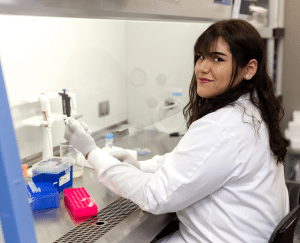 Karla S. Arcelay Garcia es estudiante del programa de Microbiología con menor en Pre Médica en la Universidad Interamericana de Puerto Rico, Recinto de Aguadilla. Participará en el simposio con una presentación afiche, titulada Detection of Vibrio spp. via microbiological and molecular biology techniques. Su futura área de estudio es MD-PhD. Su motivación para realizar esta investigación surge de un profundo interés en la identificación y monitoreo de especies del género Vibrio (Vibrio spp.) en cuerpos de agua en Puerto Rico. Dado que estas bacterias pueden representar un riesgo significativo para la salud pública y el ecosistema acuático. Su participación en el evento resalta su compromiso con la investigación y el desarrollo académico en su campo de estudio.
Karla S. Arcelay Garcia es estudiante del programa de Microbiología con menor en Pre Médica en la Universidad Interamericana de Puerto Rico, Recinto de Aguadilla. Participará en el simposio con una presentación afiche, titulada Detection of Vibrio spp. via microbiological and molecular biology techniques. Su futura área de estudio es MD-PhD. Su motivación para realizar esta investigación surge de un profundo interés en la identificación y monitoreo de especies del género Vibrio (Vibrio spp.) en cuerpos de agua en Puerto Rico. Dado que estas bacterias pueden representar un riesgo significativo para la salud pública y el ecosistema acuático. Su participación en el evento resalta su compromiso con la investigación y el desarrollo académico en su campo de estudio. Kimberly Valentín Acevedo es estudiante del programa de BS Biotecnología con menor en Toxicología en la Universidad Interamericana de Puerto Rico, Recinto de Aguadilla. Participará en el simposio con una presentación afiche titulada Pioneering Extremophile Biotechnology at Interamerican Puerto Rico: The Case of Sulfolobus spp. Su futura área de estudio es un PhD en Farmacología. Su motivación para realizar esta investigación surge de su deseo de ser parte del desarrollo innovador en la industria biotecnológica ya que tiene como meta formar parte de un equipo que esté constantemente buscando maneras para mejorar la calidad de vida y erradicar enfermedades. Su participación en el evento resalta su compromiso con la investigación y el desarrollo académico en su campo de estudio.
Kimberly Valentín Acevedo es estudiante del programa de BS Biotecnología con menor en Toxicología en la Universidad Interamericana de Puerto Rico, Recinto de Aguadilla. Participará en el simposio con una presentación afiche titulada Pioneering Extremophile Biotechnology at Interamerican Puerto Rico: The Case of Sulfolobus spp. Su futura área de estudio es un PhD en Farmacología. Su motivación para realizar esta investigación surge de su deseo de ser parte del desarrollo innovador en la industria biotecnológica ya que tiene como meta formar parte de un equipo que esté constantemente buscando maneras para mejorar la calidad de vida y erradicar enfermedades. Su participación en el evento resalta su compromiso con la investigación y el desarrollo académico en su campo de estudio. Lizmarie Ruiz Zambrana es estudiante del programa de Microbiología en la Universidad Interamericana de Puerto Rico, Recinto de Aguadilla. Participará en el simposio con una presentación de afiche, titulada Temperature-Dependent Growth of Coagulase-Positive Staphylococcus aureus in Ready-to-Eat Potato Salad: Implications for Food Safety. Su futura área de estudio es medicina. Su motivación para realizar esta investigación surge del interés por la microbiología de alimentos y la implicación del buen manejo y almacenamiento de estos para garantizar la inocuidad alimentaria. Su participación en el evento resalta su compromiso con la investigación y el desarrollo académico en su campo de estudio.
Lizmarie Ruiz Zambrana es estudiante del programa de Microbiología en la Universidad Interamericana de Puerto Rico, Recinto de Aguadilla. Participará en el simposio con una presentación de afiche, titulada Temperature-Dependent Growth of Coagulase-Positive Staphylococcus aureus in Ready-to-Eat Potato Salad: Implications for Food Safety. Su futura área de estudio es medicina. Su motivación para realizar esta investigación surge del interés por la microbiología de alimentos y la implicación del buen manejo y almacenamiento de estos para garantizar la inocuidad alimentaria. Su participación en el evento resalta su compromiso con la investigación y el desarrollo académico en su campo de estudio. La Dra. Madeline Velázquez posee un bachillerato en ciencias (B.S.) en Microbiología Industrial de la Universidad de Puerto Rico Recinto de Mayagüez. Luego completó una maestría (M.S.) y un doctorado (Ph.D.) en Microbiología de Alimentos de la Universidad de Minnesota en St. Paul, Minnesota. Su disertación doctoral se tituló “Potential role of human gut microflora and exogenous probiotic bacteria in the metabolism of dietary precursors with potential health benefits”. También realizó un grado postdoctoral en Investigación Clínica en el Centro de Ciencias de la Salud de la Universidad de Texas en San Antonio, Texas.
La Dra. Madeline Velázquez posee un bachillerato en ciencias (B.S.) en Microbiología Industrial de la Universidad de Puerto Rico Recinto de Mayagüez. Luego completó una maestría (M.S.) y un doctorado (Ph.D.) en Microbiología de Alimentos de la Universidad de Minnesota en St. Paul, Minnesota. Su disertación doctoral se tituló “Potential role of human gut microflora and exogenous probiotic bacteria in the metabolism of dietary precursors with potential health benefits”. También realizó un grado postdoctoral en Investigación Clínica en el Centro de Ciencias de la Salud de la Universidad de Texas en San Antonio, Texas. Eliezer Meléndez González es estudiante del programa de Maestría en Biología con especialidad en Biotecnología Molecular. Su objetivo a largo plazo es continuar desarrollándose integralmente como persona, combinando su crecimiento personal con su formación científica. Participará en el simposio con una presentación tipo afiche. El título de su presentación es «Aumentando la conversión de tioles 3MH y 4MMP en Saccharomyces cerevisiae para la Enología». Su participación destaca su compromiso con la investigación en el área de biotecnología aplicada a la ciencia de los alimentos y bebidas fermentadas.
Eliezer Meléndez González es estudiante del programa de Maestría en Biología con especialidad en Biotecnología Molecular. Su objetivo a largo plazo es continuar desarrollándose integralmente como persona, combinando su crecimiento personal con su formación científica. Participará en el simposio con una presentación tipo afiche. El título de su presentación es «Aumentando la conversión de tioles 3MH y 4MMP en Saccharomyces cerevisiae para la Enología». Su participación destaca su compromiso con la investigación en el área de biotecnología aplicada a la ciencia de los alimentos y bebidas fermentadas.